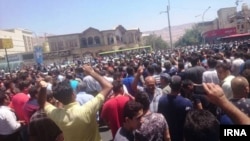Parliament Research Center of the Iranian legislature says that eleven percent more people have fallen below poverty line in the Tehran region, as the national currency rial has lost value.
Currently, the poverty line is defined as a monthly income of around 28 million rials for a family of our, which only makes about $233 based on the free market exchange rate, or $480 based on the official exchange rate of the upcoming government budget.
This means that 11 percent more of the greater Tehran population has fallen under the poverty line only during last summer compared to the spring period and 22 percent more since spring of 2017.
In other large cities also purchasing power has declined and more people are now below the poverty line.
Wage growth since last year has been insignificant and has not helped the purchasing power of ordinary people, who have the same income but have to buy many necessities, which have simply become more expensive as a result of the falling national currency.
Every food related item or raw material imported now costs more money, even though the government gives major importers cheaper dollars. Part of the problem is that even goods imported with subsidized dollars end up being sold at much higher prices at the retail level.
Last year this time, 40,000 rials would buy a U.S. dollar on the open market. Now the exchange rate is 120,000; a three-fold increase. The rial had actually declined to 180,000 to the dollar but the government has been able to stabilize it at around 120,000. But with falling oil exports and stringent U.S. sanctions, there is no guarantee that the rial would not experience another major fall.
The parliament research center also has calculated that more people have fallen below the poverty line in rural areas than in cities.
Throughout 2018, rounds of major protests and widespread strikes have delivered more blows to Iran’s economy. As hardship gets worse the chances of more unrest also increases.




